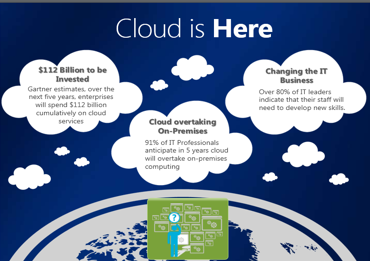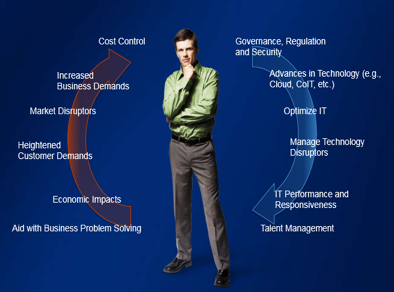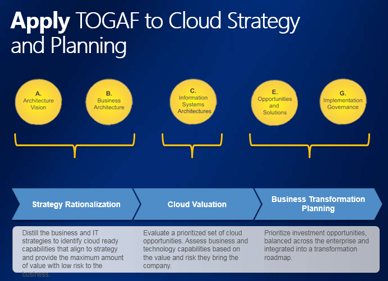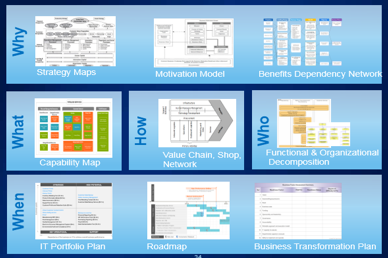Why Enterprise Architects Must Drive Cloud Strategy and Planning
 Written by Mike Walker, IT Director | Enterprise Information Architecture , Dell Corporation
Written by Mike Walker, IT Director | Enterprise Information Architecture , Dell Corporation
Previously, we talked about the ways to achieve a balance between value and risk in order to get the most out of your cloud investments. In that post I identified the methods and tools used to identify value and minimize risk for your company.
However, you maybe wondering what type of role is best to deliver on this? In this post I want to talk about why Enterprise Architects (EAs) should be on point to drive cloud strategy and planning.
Last year I presented about this at the Open Group Conference in San Francisco. The presentation was titled, "Why EA's Must Drive Cloud Strategy and Planning". There I drove the core message around why the EA should lead Cloud Strategy efforts but then quickly diving into how EA’s can drive this. I use a real world example and show a framework and method I created to provide a repeatable and predictable set of outcomes. This post elaborates on that session.
You can find the slideshare presentation here:
https://www.slideshare.net/mikejwalker/why-eas-must-drive-cloud-strategy
Cloud Computing is Here
The cloud changes things quite a bit for IT. There are massive investments and internal changes that have to occur in businesses to support this new paradigm, as shown here:

Given this, cloud computing is one of the most transformational developments in information technology since the advent of the Internet, and it has entered into the environment at a very dynamic, volatile time. Driving significant impact for the enterprise, it has its own unique set of IT benefits and risks. Providing an environment where heightened IT business demands can dovetail with new, disruptive technologies, the cloud can eliminate many of the classic IT problems, while setting the stage for broad business opportunity.
Organizations still recovering from an unpredictable economy often take a conservative stance on investments in new technologies, however. In a 2012 study by The Standish Group, respondents reported that they felt 50% of all IT projects are a waste of money. The survey also unearthed even more negative feelings around IT projects, stating that:
• 31% of all projects are cancelled before completion
• 88% of projects run over schedule, over budget—or both
• 52.7% of projects will cost 189% of their original estimates
• Average time overrun is 222% of original estimates
A move to the cloud can be a terribly risky undertaking—especially for those of us who have been through a massive re-platforming like a mainframe migration project, or a large-scale new capability like CRM or ERP. Companies have learned from those very painful processes that they need their top talent and a rigorous repeatable and predictable process to achieve success.
To this end, which role is best equipped in the enterprise to solve this problem? Enterprise Architects. Owing to their breadth of coverage and level of responsibility, EAs function a lot like “mini CIOs,” and are an excellent fit for strategy and planning roles. They possess the skillsets required to execute meaningful cloud strategy, and they have the methods, models, and tools to get the job done right.
Now let’s examine the key reasons that EAs are best equipped to handle cloud strategy and planning.
Competencies
The unique skillset of an EA enables them to effectively drive IT strategy and facilitate or partner on the creation of business strategy, as shown here:

Methods
By leveraging enterprise architecture methods like TOGAF, the EA has a unique understanding of the broader transformation across people, process and technology, as seen below:

Tools
Enterprise Architects have a comprehensive toolbox of effective tools (see below) that allow them to accelerate and effectively build out strategies that can be used for transformative cloud initiatives.

Conclusion
There is a clear opportunity for IT to leverage enterprise architecture to overcome IT’s long-standing reputation for achieving “less-than-optimal” results, and not driving value back to the business. Careful strategic planning is a must. When it comes to the cloud, which represents the convergence of CIO business challenges and advanced technology enablement, the Enterprise Architect brings a set of core competencies that connect strategy to execution, resulting in an actionable transformation strategy that can drive impact down through initiatives, programs, and projects.
By applying a simplified version of The Open Group Architecture Framework (TOGAF) to cloud strategy and planning you can achieve the maximum return on investment. The macro phases to a cloud strategy and planning method are:
• Strategy Rationalization - Distill the business and IT strategies to identify cloud-ready capabilities that align to strategy, and provide the maximum amount of value with low risk to the business
• Cloud Valuation - Evaluate a prioritized set of cloud opportunities, and assess business and technology capabilities based on the value and risk they bring the company
• Business Transformation Planning - Prioritize investment opportunities, balanced across the enterprise and integrated into a transformation roadmap
Overall, Enterprise Architects facilitate the assimilation of extreme change. They have the business acumen to ensure that the right investments are being built into the cloud; they are the most equipped in the enterprise to manage these complex strategies; and they have the influence to manage the organizational change management required.